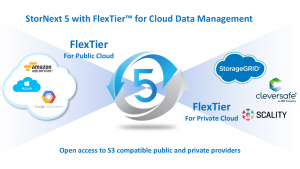SVG Europe Sit-Down: Quantum’s Janet Lafleur discusses sports production needs and future of archiving and storage
Fully digital HD workflows with multiple camera formats are increasing the demands on those companies that supply storage solutions. According to Quantum, there are few storage solutions that are up to the task of simultaneous multiple ingest, transcode, editing and delivery especially at 4K resolutions.
The company, though, has the solution with its StorNext 5 platform that was designed from the ground up for media, and forms the ideal foundation for broadcast workflows. According to senior product marketing manager Janet Lafleur, sports broadcasting is an ideal environment for the solution.
How does the StorNext platform help sports broadcasters and production companies?
Sports is on the cutting edge of video production. Broadcasters and production companies are leading the way into 4K/8K resolutions and moving to leverage high dynamic range (HDR) and higher frame rates (HFR) to deliver crisper and more vivid images. They are using more and varied cameras at each event and delivering content in more ways to address consumer demand for a better — even personalised — experience of the action, up close and behind the scenes.
A growing variety of production teams from leagues, conferences, universities, arenas and stadiums are moving to manage and deliver content not only to broadcast outlets, but also to online portals and social media. Content is being created for broadcast, on-demand and pay-per-view services, and streaming services, as well as for viewing on the venue’s video boards, and archived content is realising new value and importance as it is incorporated into these many different creations.
All of these factors are driving demand for greater storage capacity, performance and accessibility, and the StorNext storage platform is engineered to meet this demand. In fact, leading sports production groups count on StorNext to support their operations. At Globosat, for instance, StorNext has supported the collaborative file-based editing workflow for nearly a decade, and the system enabled rapid expansion of storage infrastructure to address the high demands of Rio 2016.
The StorNext platform allows teams of editors to access shared content quickly and seamlessly via SAN and LAN, from both Mac and Windows workstations, regardless of the storage medium – spinning disk, solid-state disk, object storage, tape and cloud. With intelligent policy-based movement of content across a facility’s storage systems, optimised to address performance and capacity requirements, sports production companies can maintain the fast, reliable access to content that is essential to quality and timely coverage of the game, match or race.
What benefits does StorNext 5.4 bring to sports users?
StorNext 5.4 offers capabilities that bring new levels of efficiency and flexibility to media content management. The platform’s new FlexTier cloud access capability makes it easy to integrate existing public cloud storage accounts and third-party object storage (private cloud) into a StorNext environment and into familiar media workflows. As a result, sports production teams get all the content access and visibility benefits provided by StorNext, and the business can continue to leverage its investment in private cloud object storage systems and public cloud storage services. This model makes large-scale archives more economical and simplifies their integration into the overall workflow, in turn making it easier for creative teams to access all stored content and build it into any production.
Presumably, users require scalability so that assets can be subsequently added. How do you achieve this?
Scale-out storage powered by StorNext 5 data management not only meets the most demanding performance requirements, but also enables users to scale to hundreds of petabytes. For sports production companies working with StorNext, expanding the storage infrastructure is as simple as adding more online storage or moving content to integrated, transparently accessible, archive tiers of object storage, tape or cloud storage.
Has there been a discernible trend towards investment in high-end digital archiving solutions for sports applications?
 Yes, in the sense that archives are evolving into online digital libraries that serve as much more than a final destination for content. Whether on object storage, tape or the cloud, archives have begun delivering the performance and accessibility necessary to replace nearline disk storage for active archives. They are being defined by degrees of content accessibility rather than by the cost, type, durability or storage medium itself. Ultimately, this shift will lead sports production teams to think of and use archives as a service, with accessibility and cost optimised through intelligent data and asset management.
Yes, in the sense that archives are evolving into online digital libraries that serve as much more than a final destination for content. Whether on object storage, tape or the cloud, archives have begun delivering the performance and accessibility necessary to replace nearline disk storage for active archives. They are being defined by degrees of content accessibility rather than by the cost, type, durability or storage medium itself. Ultimately, this shift will lead sports production teams to think of and use archives as a service, with accessibility and cost optimised through intelligent data and asset management.
Has the increase in multi-screen activities in sports broadcasting had any impact on archive and storage demands?
In the multiscreen, multiplatform world of sports production and delivery, broadcasters must address tremendous demand from always-on devices that require content more often and in more formats than ever. The need to maintain media and keep it available for future repurposing is one fundamental challenge, and it is intensified by the growth in file sizes and data volume, as well as ever-present cost pressures. The impact is significant: Storage must provide high performance and exceptional scalability in the most cost-effective manner possible, and this is no small task. Addressing the many distribution formats associated with multiplatform delivery calls for more than the addition of capacity. Given the much greater volume of transcoding that must be performed, it is essential that transcode and delivery functions be well-integrated into a larger streamlined workflow.
Should archiving and storage be a standalone function – or a part of a wider MAM solution? Quantum’s StorNext is tightly integrated with many of the industry’s most popular MAM solutions, uniting the seamless, automated movement of assets between disk, tape, object storage and cloud resources with the robust capabilities today’s asset management systems provide. This is a powerful combination that enables greater efficiency and productivity across the content creation and delivery chain. StorNext Storage Manager provides policy-based data movement directly within the shared file system when a MAM is not suitable or desired. That said, stand-alone archiving and storage that’s not integrated with a MAM or by a shared file system creates silos that inhibit workflow efficiency and waste valuable storage space.
What is the next biggest innovation relating to archive and storage?
With archive and storage, the most impactful innovation in the near term will be infrastructure or tools that enable cloud storage services to be seamlessly integrated into existing workflows, rather than forcing the workflow to adapt for the cloud. The cloud has been embraced broadly as an attractive option for off-site backup, and now the cloud — private object storage and public storage services — is coming into its own as a readily accessible media archive supporting not only delivery, but post-production as well. A growing number of different MAM tools have cloud capabilities built in, which means that media storage in the cloud is becoming ever more capable of supporting collaborative content creation workflows.

